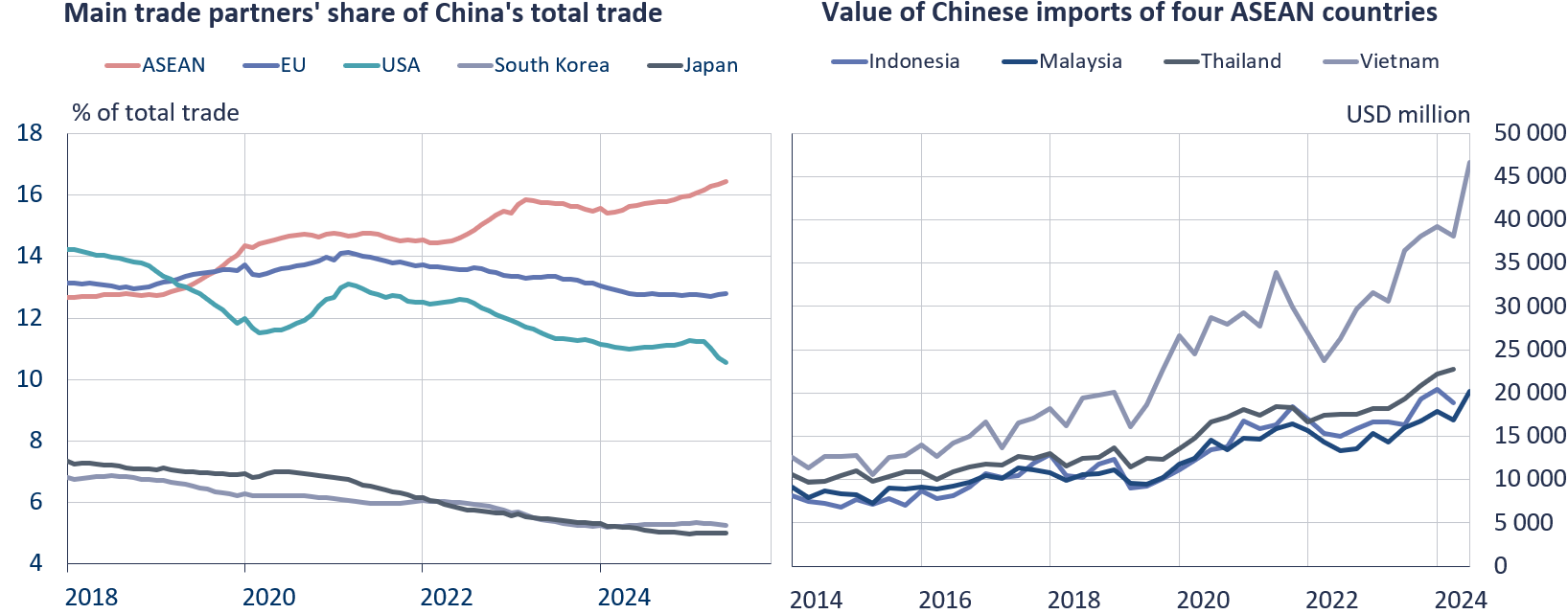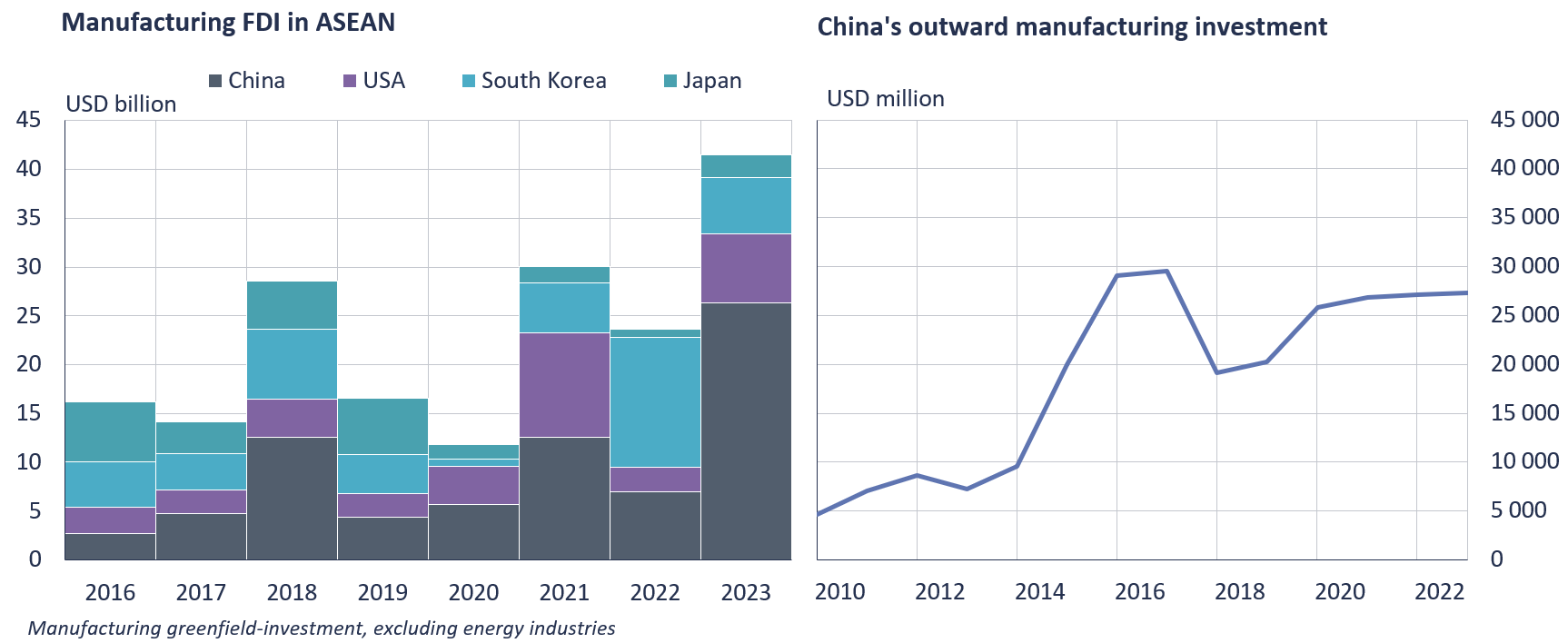BOFIT Weekly Review 30/2025
The economies of China and Southeast Asia are highly interlinked
China and the Association of Southeast Asian Nations (ASEAN) recently wrapped up negotiations on an upgrade of their free-trade agreement. ASEAN consists of ten member countries, including Indonesia, Vietnam, Thailand and the Philippines. The ASEAN countries expanded their own free-trade area (AFTA) to incorporate bilateral trade with China in 2010. Negotiations on updating the agreement with China began in 2022. The new arrangement covers digital technologies and technologies critical to the green transition, as well as cooperation on streamlining of customs and supply chain procedures.
ASEAN is China’s biggest trading partner. China Customs figures value Chinese trade with ASEAN countries at $234 billion in the first quarter of 2025, pointing to a strong likelihood that the value of trade could exceed $1 trillion this year. Trade with ASEAN countries represents almost 20 % of China’s total foreign trade.
ASEAN is China’s biggest trading partner.

Sources: China Customs, Macrobond, CEIC and BOFIT.
Southeast Asia has become a major destination for Chinese manufacturing investment as Chinese firms seek to take advantage of cheap labour, large markets and central location with respect to international supply chains. Investment of Chinese firms in industrial capacity in Southeast Asia also helps circumvent tariffs placed on Chinese goods by various countries. Chinese investment in ASEAN countries soared during president Donald Trump’s first term after the US imposed substantial tariffs on China.
ASEAN’s own figures show Chinese industrial investment in the region was still quite modest in 2022 (8 %). ASEAN’s official figures, however, do not include holding companies or offshore vehicles for investment. As a result, the bulk of China’s actual investment activity is not mentioned in the official numbers. A significant share of Chinese corporate investment abroad is routed via Hong Kong. According to the FDI tracking service fDi Markets, which provides more detailed breakdowns of international investment activity, the value of greenfield investment by Chinese firms in the ASEAN region exceeded $26.4 billion in 2023. Chinese investment was about $10 billion more than the combined investments of the US ($7 billion), South Korea ($5.7 billion) and Japan ($2.4 billion). Since the start of the US-China trade war in 2018, new investments of Chinese firms in ASEAN countries have roughly doubled.
China’s outward direct investment focuses heavily on manufacturing in ASEAN countries

Sources: China Customs, CEIC, BOFIT, and fDi Markets.
The think tank Rhodium Group and fDi Markets both report that an average of 45 % of China’s FDI has recently been directed to ASEAN countries. Most investment has gone to manufacturing industries. The chemical and steel industries have traditionally been the main investment targets of Chinese companies in Southeast Asia, but an increasing amount of investment has recently gone to manufacturing of electrical vehicles, smart phones, as well as technologies for battery and semiconductor production. Chinese investment is especially concentrated in four ASEAN countries: Indonesia, Vietnam, Thailand and Malaysia. In Indonesia, Chinese firms have made significant investments in production of electric vehicles, while small and medium-sized investments have more typically gone to facilities in Thailand, Vietnam and Malaysia. In terms of value, the automotive industry accounted for 45 % of Chinese investments in ASEAN countries between 2018 and 2024, information and communications technologies, electronics and renewable energy technologies 15 % each and consumer goods 9 %.
China has recently been more active in cultivating relations with ASEAN members. Chinese president Xi Jinping even toured Southeast Asia in April following by Trump’s April 2 announcement of “reciprocal” tariffs that included high tariffs on imports from China and Southeast Asian countries. During the visit, president Xi spoke against protectionism and unilateralism.
China’s relations with member states have become inflamed, however, due to the glut of Chinese-produced steel and fierce price competition with Chinese firms. Industrial intermediate products account for the bulk of China’s exports to Southeast Asia, but the countries have been concerned that Chinese firms increasingly seek to export consumer goods to member states. Indonesia’s textile industry has fallen victim to this change as Chinese online sales platforms have overtaken the domestic market. Indonesia’s textile-makers had to lay off roughly 80,000 employees during 2024.